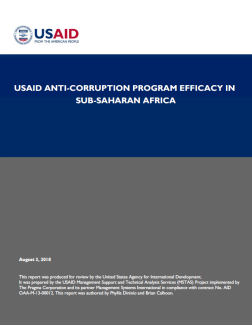The purpose of this study is to analyze the effectiveness of USAID programming in meeting anti-corruption goals in sub-Saharan Africa. The research will serve as a foundation for informing future anti-corruption program design and implementation, and may lead to further analysis. The research team focused on 90 USAID programs over the past decade with a stated focus, in whole or in part, on anti-corruption, accountability, transparency or integrity. They read available documents and interviewed USAID staff associated with the programs. The review included programs with a primary focus on anti-corruption and those with another focus that contained anti-corruption sub-objectives, indicators or reporting.
The review revealed trends in the levels and areas of focus of programming over the period 2008 to 2018. The amount of anti-corruption programming has been somewhat stable over the period, although it experienced a notable uptick between 2014 and 2017, followed by a drop in 2018. The drop may reflect the decrease in DRG funding for the region. Anti-corruption programming occurred more often in the civil society, local governance and rule of law sub-sectors and less often in non-DRG sectors such as economic growth, natural resource management and health. The majority of anti-corruption programs combined demand- and supply-side approaches, working with both civil society to “demand” and government to “supply” anti-corruption measures. Although combining both demand- and supply-side approaches in a single program is considered a best practice, the period witnessed a steady increase in programs focused only on the demand for anti-corruption measures.
Programs with a primary focus on anti-corruption represented a little more than a third of all anti-corruption related programs. By and large, USAID’s programming with a primary focus on anti-corruption occurred in countries categorized as Free or Partly Free by Freedom House. With more political and civic freedom, these contexts likely enabled USAID and other donors to be more open
Anti‐Corruption Program Efficacy in Sub‐Saharan Africa about addressing corruption. In addition, USAID programs with a primary focus on anti-corruption occurred more often in countries with higher scores on the World Bank’s Control of Corruption indicator. These programs tended to combine demand- and supply-side approaches.
In countries where USAID had a clear understanding of the level of political will within the government, programs were better targeted to take advantage of opportunities and respond to constraints. In Liberia, USAID had initially overestimated some government partners’ ability and willingness to tackle key reforms. They learned from this experience and their current programming is designed to adapt to emerging opportunities.1 Even in closing political space, Missions can promote anti-corruption by focusing on sectors that align with the objectives of the government, as recent programs in Tanzania illustrate

